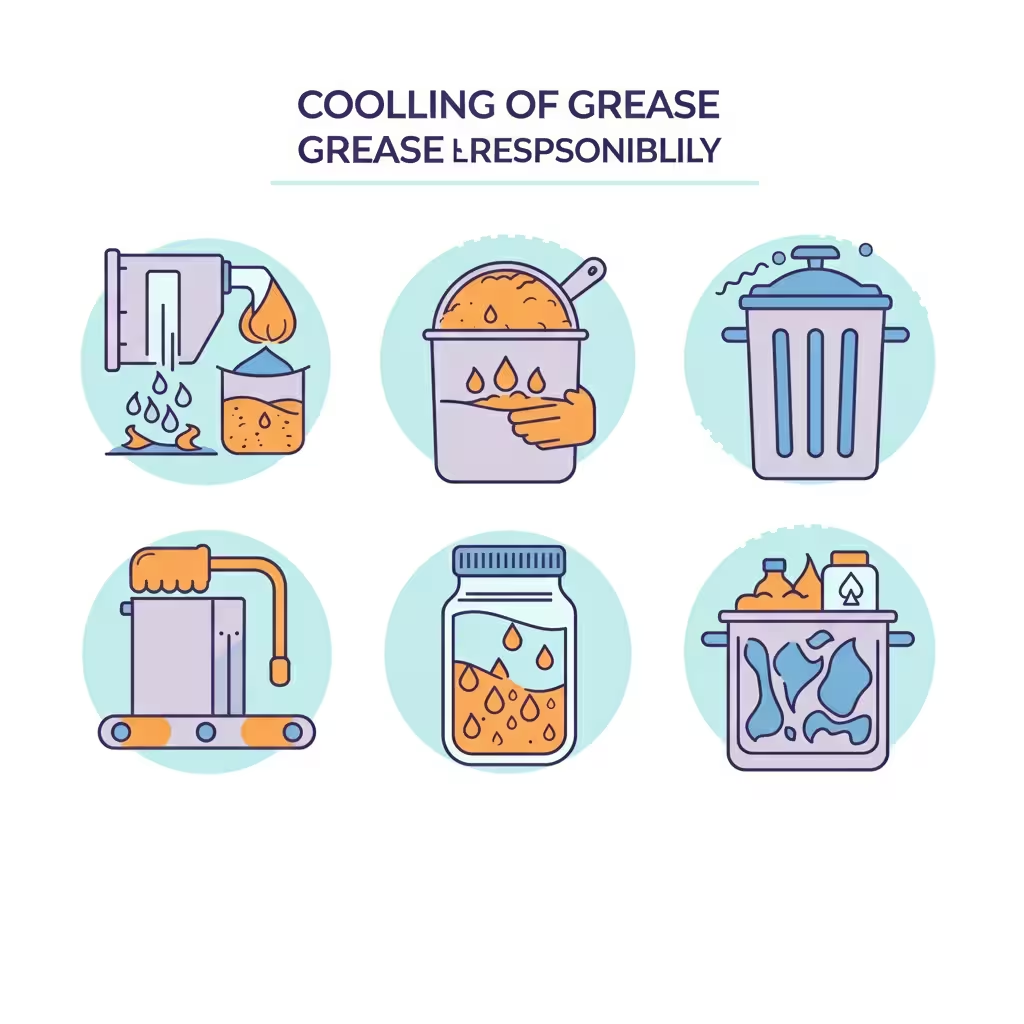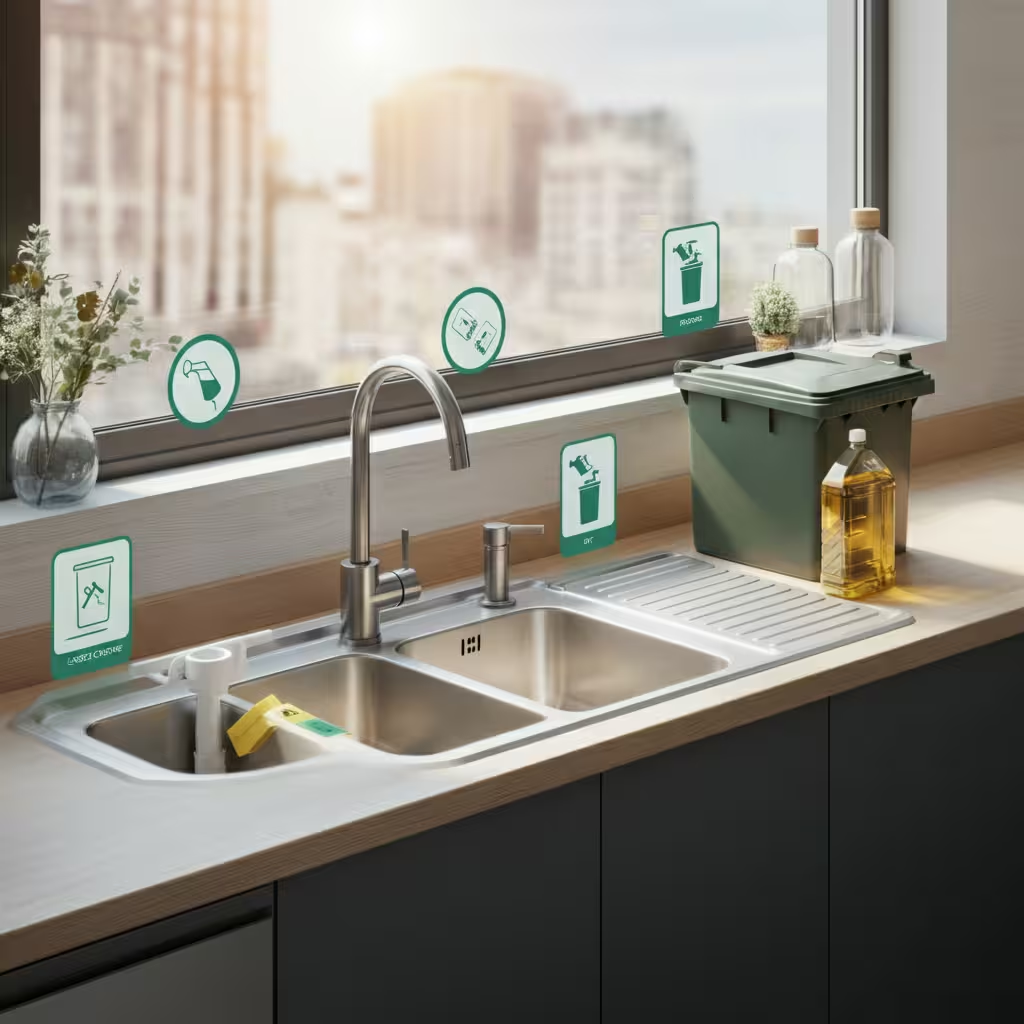After you’ve cooked a delicious meal with bacon, ground beef, or fried chicken, you’re often left with a pan full of hot, liquid grease. What should you do with it? Your first thought might be to pour it down the sink, but this simple act can cause major plumbing disasters, environmental harm, and expensive repairs. Learning how to dispose of grease properly is a critical skill for every household and food business.
This guide will walk you through the safest and most effective methods for managing used cooking oil and fats. We will cover why improper disposal is so harmful, provide step-by-step instructions for getting rid of it at home, and explain the professional solutions for managing larger quantities of fats, oils, and grease (FOG).
Why You Should Never Pour Grease Down the Drain
Pouring fat, oil, or grease down your sink is one of the worst things you can do to your plumbing system. While it may be a hot liquid when it leaves the pan, it doesn’t stay that way for long. This is a crucial point to understand when learning how to dispose of grease.

The Problem with FOG in Your Pipes
As grease moves down your pipes, it cools and solidifies. It clings to the inner walls of the pipes, slowly building up over time like plaque in an artery. This sticky residue traps food particles, hair, and other debris, creating stubborn clogs. These blockages, often called “fatbergs,” can lead to slow drains, complete backups of raw sewage into your home, and even burst pipes. The result is often an expensive and unpleasant plumbing emergency.
Environmental Impact of Improper Grease Disposal
When FOG escapes residential plumbing, it enters the municipal sewer system. Here, it mixes with grease from other homes and restaurants, forming massive fatbergs that can block entire sewer lines. These blockages can cause sanitary sewer overflows (SSOs), where untreated wastewater spills into streets, parks, and waterways. This pollutes our environment, harms aquatic life, and creates a significant public health risk. Cities spend millions of dollars annually to remove these blockages and repair the damaged infrastructure.
Safe and Simple Ways for How to Dispose of Grease at Home
Now that you understand the risks, let’s explore the correct methods for grease disposal. The best approach depends on the amount and type of grease you have. This section provides a practical guide on how to dispose of grease from your daily cooking.
1. The “Can It and Trash It” Method
This is the most common and highly recommended method for small amounts of household cooking grease.
- Cool It Down: Let the grease cool in the pan until it’s warm but not scalding hot. Never try to handle a pan full of hot oil, as it can cause severe burns.
- Pour It into a Container: Carefully pour the cooled grease into a non-recyclable, sealable container. Good options include an old coffee can, a glass jar with a tight lid, or an empty milk carton. Avoid using flimsy plastic bags that can tear and leak.
- Solidify and Seal: Place the container in the refrigerator or freezer. This allows the grease to solidify completely, which minimizes the chance of messy leaks in your trash can.
- Toss It in the Trash: Once the grease is solid, seal the container tightly and throw it into your regular household garbage.
2. Wiping and Scraping Small Amounts
For pans with only a thin layer of grease, you don’t need a separate container. This is another easy way for how to dispose of grease.
- Wait for the pan and grease to cool down completely.
- Use a paper towel or a spatula to wipe or scrape the solidified grease out of the pan.
- Dispose of the greasy paper towel or remnants in the trash. This method is perfect for the residual grease left after cooking burgers or sausage.
3. Mixing with Absorbent Materials
If you don’t have a spare container, you can mix liquid oil with absorbent waste materials.
- Pour the cooled oil into a bag that contains materials like used coffee grounds, cat litter, or sawdust.
- These materials will absorb the oil, making it less likely to leak.
- Tie the bag securely and dispose of it in your garbage bin.
Can You Reuse Cooking Oil?
In some cases, you can reuse cooking oil, which is both economical and environmentally friendly. This works best for oil used for deep-frying.
- Strain the Oil: After the oil has cooled, use a fine-mesh sieve or cheesecloth to strain out any food particles.
- Store Properly: Pour the strained oil into a clean, airtight container. Store it in a cool, dark place away from light and heat. Label the container with the date and what you used it for (e.g., “Fish Fry Oil”).
- Know When to Discard: Do not reuse oil that has a rancid smell, appears dark and foamy, or smokes at a lower temperature than usual. Also, avoid mixing oils used for different foods, as flavors can transfer. After two or three uses, it’s best to discard the oil using the methods described above.
What About Large Quantities of Grease?
Households that do a lot of deep-frying or commercial kitchens generate large volumes of FOG that cannot simply be thrown in the trash. In these situations, you need a more robust solution for how to dispose of grease.
Residential Oil Recycling Programs
Check with your local waste management authority or public works department. Many municipalities have designated recycling centers or collection events specifically for used cooking oil. These programs often partner with facilities that convert the collected oil into biodiesel, a renewable fuel source. This is an excellent way to handle gallons of turkey fryer oil after the holidays.
Professional Grease Management for Businesses
Restaurants, food processing plants, and other commercial food service establishments are legally required to manage their FOG output. This involves using specialized equipment and professional services to stay compliant. Knowing how to dispose of grease at a commercial scale is non-negotiable.
- Grease Traps and Interceptors: These are plumbing devices designed to intercept FOG before it enters the sewer system. Grease traps are smaller units usually located under sinks, while grease interceptors are large, outdoor, in-ground tanks.
- Professional Pumping and Cleaning: These systems must be regularly pumped and cleaned by a licensed FOG management company. Professionals safely remove the collected grease and transport it to a processing facility for proper disposal or recycling, ensuring your business meets all local health and environmental regulations.
Failure to maintain these systems can result in heavy fines, business closures, and liability for any damage caused to the municipal sewer system.
A Cleaner, Safer Future Starts in Your Kitchen
Learning how to dispose of grease correctly is a small change in your daily routine that creates a massive positive impact. By keeping FOG out of our pipes and sewer systems, you protect your home from costly plumbing emergencies, help prevent environmental contamination, and contribute to the health and safety of your entire community.
Remember the key steps: cool it, contain it, and trash it. For larger amounts, seek out local recycling options. And if you run a business, partner with a trusted FOG management expert to ensure you are compliant and responsible. Your pipes—and your city—will thank you for it.

